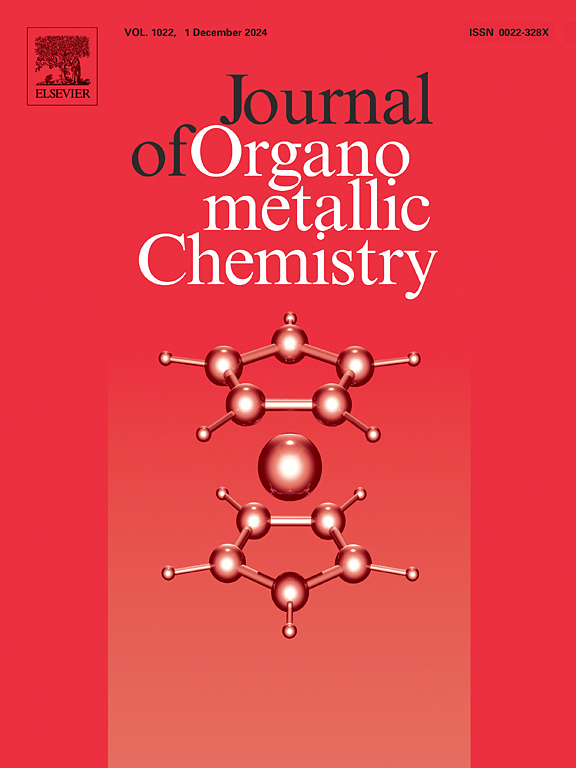五甲基环戊二烯基钌(III)羧酸配合物的合成、计算筛选、抗糖尿病、抗菌、DNA、药代动力学/ ADMET分析和分子对接研究
IF 2.1
3区 化学
Q3 CHEMISTRY, INORGANIC & NUCLEAR
引用次数: 0
摘要
本研究报道了设计的五甲基环戊二烯基羧酸钌配合物[Ru*Cp (TA)Cl]的合成、表征、计算研究和生物学评价。通过FTIR, UV-Visible, 1HNMR和元素分析对其进行了结构评价。得到的Δυ (as COO- sm COO-)结果为244 cm-1,探索了羧酸段的双共轭模式。利用DTF / B3LYP方法进行量子计算以确定结构参数。基于振动模态总能量分布(TED),利用尺度量子力学(SQM)计算振动频率,采用基集(B3LYP / 6-31 G (d, p) LanL2DZ)进行振动频率计算。在FMO计算中,低能隙[LUMOHOMO]用于评估总体反应性参数(GPR)、电荷转移和生物活性。结构-活性关系(SAR)被用来解释体外生物活性结果如何支持硅研究结果。ssdna结合常数为3.3 × 106±2.73 M-1,表明[Ru*Cp (TA)Cl]与DNA有很强的结合潜力,对接评分为-6.62 Kcal/mol。该复合物对枯草芽孢杆菌(5ZW4)具有较强的抑菌活性,活性指数为90.12±0.07% (p <;0.05), 1C50 = 5.43±0.02 mM,结合亲和力为-9.93 Kcal/mol。与常规药物相比,该配合物具有较低的α-淀粉酶抑制电位。预测药代动力学参数表明,金属配合物具有理想的药物样品质,使其成为未来治疗发展的有趣候选者。本文章由计算机程序翻译,如有差异,请以英文原文为准。

Synthesis, computational screening, antidiabetic, antibacterial, DNA, pharmacokinetics/ ADMET analysis and molecular docking studies of pentamethylcyclopentadienyl ruthenium(III) carboxylate complex
The current study reports synthesis, characterization, computational investigation and biological evaluation of designed pentamethylcyclopentadienyl ruthenium(III) carboxylate complex [Ru*Cp (TA)Cl]. Structural evaluation has been done via FTIR, UV–Visible, 1HNMR and elemental analysis. The obtained Δυ (υas COO- – υsm COO-) findings found as 244 cm-1, which explore bidendate mode of carboxylate moiety. Quantum computations were performed utilizing the DTF / B3LYP methodology to determine structural parameters. Vibrational frequency computations were performed using basis set (B3LYP / 6–31 G (d, p) LanL2DZ), based on total energy distribution (TED) of vibrational mode, which was calculated using scaled quantum mechanics (SQM). In FMO calculations, lower energy gap [LUMO![]() HOMO] was used to evaluate global reactivity parameters (GPR), charge transfer, and bioactivity. Structural-activity relationship (SAR) was employed to explain how in vitro biological activity results supported in silico findings. The SSDNA-binding constant 3.3 × 106 ± 2.73 M-1 indicated strong biding potential of [Ru*Cp (TA)Cl] with DNA which was corroborated by docking score -6.62 Kcal/mol. Studied complex has considerable antibacterial potency with Bacillus subtilis (5ZW4) exhibiting activity index 90.12 ± 0.07 % (p < 0.05) with 1C50 = 5.43 ± 0.02 mM and binding affinity equal to -9.93 Kcal/mol. The complex has lower α-amylase inhibitory potential compared to conventional drug. Predictive pharmacokinetic parameters indicate that the metal complex has desirable drug-like qualities, making as interesting candidates for future therapeutic development.
HOMO] was used to evaluate global reactivity parameters (GPR), charge transfer, and bioactivity. Structural-activity relationship (SAR) was employed to explain how in vitro biological activity results supported in silico findings. The SSDNA-binding constant 3.3 × 106 ± 2.73 M-1 indicated strong biding potential of [Ru*Cp (TA)Cl] with DNA which was corroborated by docking score -6.62 Kcal/mol. Studied complex has considerable antibacterial potency with Bacillus subtilis (5ZW4) exhibiting activity index 90.12 ± 0.07 % (p < 0.05) with 1C50 = 5.43 ± 0.02 mM and binding affinity equal to -9.93 Kcal/mol. The complex has lower α-amylase inhibitory potential compared to conventional drug. Predictive pharmacokinetic parameters indicate that the metal complex has desirable drug-like qualities, making as interesting candidates for future therapeutic development.
求助全文
通过发布文献求助,成功后即可免费获取论文全文。
去求助
来源期刊

Journal of Organometallic Chemistry
化学-无机化学与核化学
CiteScore
4.40
自引率
8.70%
发文量
221
审稿时长
36 days
期刊介绍:
The Journal of Organometallic Chemistry targets original papers dealing with theoretical aspects, structural chemistry, synthesis, physical and chemical properties (including reaction mechanisms), and practical applications of organometallic compounds.
Organometallic compounds are defined as compounds that contain metal - carbon bonds. The term metal includes all alkali and alkaline earth metals, all transition metals and the lanthanides and actinides in the Periodic Table. Metalloids including the elements in Group 13 and the heavier members of the Groups 14 - 16 are also included. The term chemistry includes syntheses, characterizations and reaction chemistry of all such compounds. Research reports based on use of organometallic complexes in bioorganometallic chemistry, medicine, material sciences, homogeneous catalysis and energy conversion are also welcome.
The scope of the journal has been enlarged to encompass important research on organometallic complexes in bioorganometallic chemistry and material sciences, and of heavier main group elements in organometallic chemistry. The journal also publishes review articles, short communications and notes.
 求助内容:
求助内容: 应助结果提醒方式:
应助结果提醒方式:


